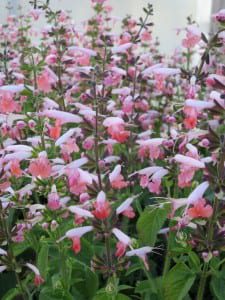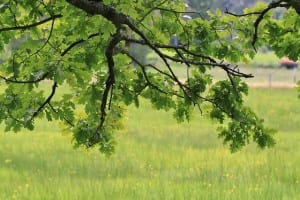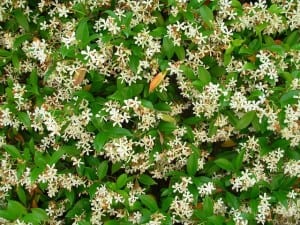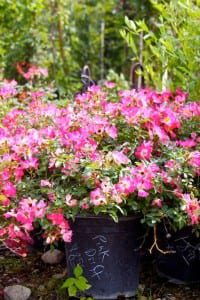It’s that time of year when we start seeing shaggy-haired boys with sun-kissed highlights, and girls with wisps of summer-bleached hair escaping from their loosely-tied back ponytails. And while it may be time for us to let our hair down and run a little carefree and wild, it would actually do some of our perennials a great service if we tidy them up some and give them a little haircut. With the past rains we’ve received, our plant growth has bolted. If foliage were hair, it would be in stiff competition with Cousin It! I think a lot of people get a little hesitant and out of their comfort zone when approaching pruning outside of the month of February. But I’m not asking you to prune during the least desirable time, like in spring right after new growth begins; and I’m not asking you to run out and perform a Texas Chainsaw Massacre on your entire backyard or anything like that. I’m simply suggesting a little cleaning and shaping up. If you tidy up some now, you can avoid that scraggly, leggy look perennial plants tend to get in the later summer months and you can get the most out of what your plants have to offer you. So let’s take a look at what plants can benefit from a little off the top.
(Wild summer hair = perfect for a happy kid. Wild perennial plants = less bloom come fall.)
Flowers/Perennials- You can really benefit by trimming back those perennials that offer up another round of blooms after springtime. A good example of what you should consider taking your shears to is salvia. Salvia blooms at the end of their shoots, so by pinching them back or shearing them back some, you create more shoots which results in more blooms. Pruning your salvia also helps you to control their height and keep them more compact. Salvia will bloom spring, summer and fall, so extend the life of the color in your garden by pruning it back from time to time. Lantana is another plant you can trim back periodically (1 to 3 inches from the tips) throughout the season to encourage new blooms. You also want to include your fall-blooming perennials like copper canyon daisy, fall aster, and chrysanthemum. Prune these fall-blooming plants back by one-third to encourage a fuller shape with more shoots to promote a spectacular fall bloom. Leave them leggy and listless, and that’s the type of bloom you will get in the fall.
(You wouldn’t want to miss out on a single bloom of this salvia, so go ahead, pinch it back and encourage it to burst forth with color.)
Herbs- How fast does the hot sun make our herbs go to seed? Seemingly overnight if you aren’t using them enough. Pinching back your basil, or snipping back your thyme forces the herb to grow in a more compact, fuller form, again by producing new shoots. Best practice is to actually use your herbs on a regular basis. Look up new summer recipes, brew up some sun tea with a few sprigs of mint, pinch of a handful of herbs just to crush between your fingers and enjoy solely for the aroma. Use your herbs so they don’t go to waste. Most herbs produce some type of flower, and while they can be beautiful, in some herbs, they signal the upcoming demise of your plant. Once the flowers are produced, and the herb starts to go to seed, the stems can turn woody and the production of your herb’s culinary leaves ceases. So unless you are specifically collecting seed, or need the flower buds (like in the case of lavender), pinch and snip your herbs to keep them healthy.
(Although it is true that this bee really appreciates the flowers on this lime basil, you would be better off pinching them off.)
Shrubs- Prune your spring-flowering shrubs no later than this month, if you procrastinate and do this later in the summer, you risk a poor bloom cycle the following spring. These spring-flowering shrubs need time to rejuvenate through midsummer and fall when they will grow heavily and set new bloom buds. Shearing classic hedges often throughout the summer will keep them full and uniform as opposed to showing little bare patches, or having unruly sprigs popping out in random places. Shear back some of your plumbago and you will be rewarded with a fresh batch of brilliant blue flowers. There are some shrubs, like pyracantha, azalea, and gardenia that hardly need pruning at all. You may find yourself clipping a little here and there one year for aesthetic purposes, and then not prune for another two years.
( A little trim and…BAM! Your plumbago has gone ballistic with brilliant blue flowers!)
Trees- At this time, you should only be concerned with pruning trees that have been damaged from a storm. Removing damaged limbs helps to prevent insect or fungal problems from attacking your tree, but no heavy pruning needs to, or should be, done at this time.
(Don’t do it. Take us at our word which is strong as an oak…the best time to prune oak trees is late fall and winter!)
Vines- You can shear back your vigorous growers to keep them looking full and to restrict them from encroaching where you might not want them to dwell. Star Jasmine is a good example of what you can shear back. It’s ok to regularly trim back vines with long shoots that wander outside of their realm. By trimming the long shoots, you are able to direct the growth where you want it to be as opposed to letting it run wild. Leave vines to their own devices for too long a period and you will end up with a tangled labyrinth filled with bees, rodents and possibly a small child. Vining groundcover can also be trimmed back to redirect it from choking out other nearby plants.
(Hey…whatcha got hidden deep in those vines?)
Roses- Consider that each time you cut a rose to place in a vase of water, you are actually doing some pruning. It’s not so scary right? Your roses actually thank you for not leaving them on the bush to wither and die and become possible victims of a thrip or spider mite infestation. We don’t recommend a hard pruning of your roses (that we like to save for February), but a clip from time to time to train your plant and maintain its health is A-OK. Shrub roses can actually be sheared back this month to promote more blooms. Remember to dip your pruners, between cuts, into a90% water to 10% clorox bleach solution to prevent cross contamination of any fungal problems.
(Shrub roses and drift roses can be sheared back some to encourage new blooms.)
Lawns- You should be mowing your grass weekly to create a dense lawn. Did I just hear a groan? We don’t want you to scalp your lawn, but mowing once a week is the least amount you should aim for. If you raise the mower height and mow even more often, you really increase the density of your lawn. Why is that important? A dense lawn puts the chokehold on weeds. So let’s weigh the despise levels of the chores: Mow lawn weekly or twice a week (not so bad with a power mower and early morning coolness or late evening breeze), or spend every day wrestling to pull stubborn weeds that seem to multiply right in front of your eyes? Hmmmm…seems like a no brainer to me. Gas up the lawn hog, please!
(Wake up early to beat the heat, and make this a weekly habit. Your summer bare feet will thank you.)
In closing, I’d like to remind you that just as a little goes a long way, a lot can go a long way too, as in a long way to recovery. Ever had a crazy whim to cut your bangs or shave your head? And then you watched your mouth form the words, “OH NO” in slow motion? How many days, weeks, months, or even years did it take you to recover from that? Exactly. Take a more conservative approach with your summer pruning for perennials and fall-blooming plants. You don’t have to be frightened, but you should start with a light hand. You’ll have plenty of opportunity to shape your plants again in the fall or early spring. You got this!
(Just a little off the top, please!)
The Happy Gardener
Lisa Mulroy










Thanks for tips on pruning salvia and copper canyon for late summer and into fall. m
Thanks for comments on pruning my salvia and copper canyon. Looking forward to the beautiful blooms come late summer, early fall.
Hi Margaret,
You are absolutely welcome! I think you will be super happy with the results!